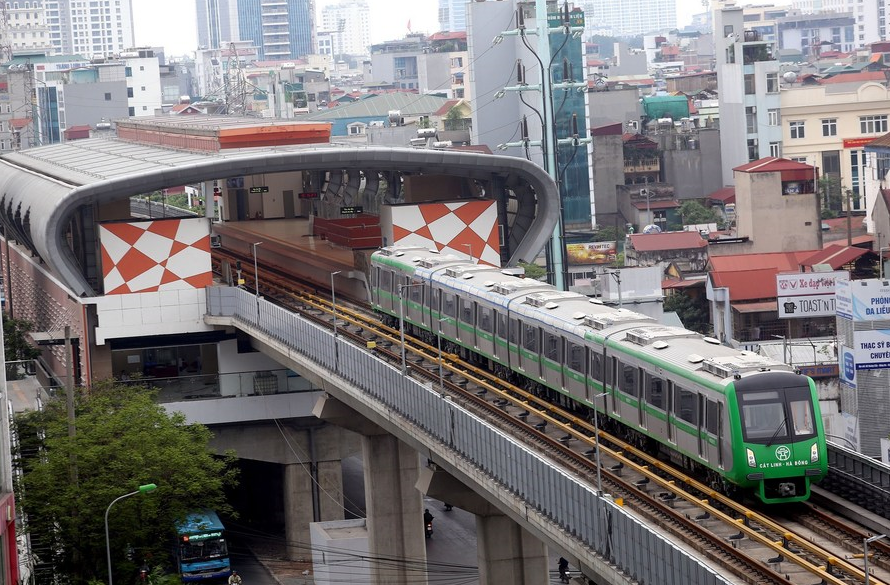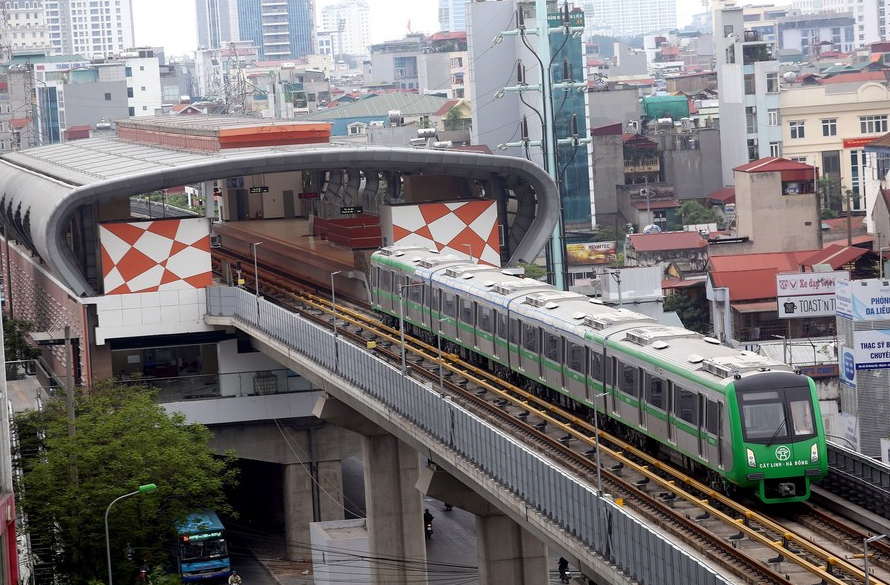
Photo taken on Nov. 6, 2021 shows a train running on Cat Linh-Ha Dong metro line in Hanoi, Vietnam. (VNA via Xinhua)
BEIJING, March 4 (Xinhua) -- China has been helping countries and regions involved in the Belt and Road Initiative (BRI) to develop clean energy by means of technical support, capacity building, consulting services, etc., which injects impetus to local green development.
China itself has also achieved significant results in developing green energy. By the end of 2021, China's installed capacity of renewable energy power generation reached 1.063 billion KW, accounting for 44.8 percent of its total installed power generation capacity. China also leads the world in installed capacity of hydropower, wind power, photovoltaic and nuclear power under construction.
Cuba -- China-aided solar power station project contributes to Cuba's modernization drive
In April 2018, after more than one year of construction and trial operation, two China-aided solar power stations were officially handed over to the Cuban government.
The 4-MW power plant based in Cuba's west province Pinar del Río and the 5-MW power plant based in Cienfuegos, can meet the household electricity consumption of 20,000 Cuban residents. The Cienfuegos power plant is the largest photovoltaic power station in Cuba.
The two power plants have created over 100 jobs for local people so far.
"I have accumulated technical experience here and now I am in charge of weekly on-site equipment inspection," said an electrical engineer working at the power plant. The Cuban engineer has fully participated in the building of the solar power plant project, and learned from Chinese workers the operation and maintenance of major equipment.
Nearby residents are the direct beneficiaries of the solar power plant project. Not far from the Pinar del Río power plant stands a small restaurant which is regularly visited by the staff of the power plant. "Most of the electricity supply in Cuba used to depending on fuel oil. Because of the shortage of raw materials, blackouts happen a lot here, affecting the business. Now with steady stream of solar power, the business turns better," said the owner of the restaurant.
China has greatly helped Cuba in developing renewable energy, and such projects have not only helped improve the living conditions of the Cuban people, but also contributed to Cuba's modernization. Great potential exists in green energy cooperation between China and Cuba, said an official from the energy and mineral resources department of the Cuban government.
Cambodia -- Green energy is delivered to thousands of households
Tatay Hydropower Station located in west Cambodia was invested and built by China National Heavy Machinery Corporation (CHMC) and was put into operation in 2014.
By the end of October 2021, this station has generated electricity of nearly 7 billion kwh.
By the end of 2020, Chinese enterprises had built 10 hydropower stations in Cambodia, the total installed capacity of which accounts for nearly 45 percent of the total in Cambodia.
Zhao Wensheng, deputy general manager of the project company of Tatay Hydropower Station, said that the green electricity provided by Chinese-funded hydropower stations not only alleviates the energy shortages in Cambodia, but also contributes to local energy conservation and emission reduction.
Wu Guoquan, the Economic and Commercial Counselor of the Chinese Embassy in Cambodia, said that Chinese enterprises have sent green energy to Cambodian homes, adding impetus to the cooperation between the two sides.
Cambodia's power system used to be low-efficient in transmitting electricity, on which Chinese enterprises have made targeted solutions. For example, CHMC has undertaken 13 power transmission and transformation projects and 34 electricity substations in Cambodia, and relevant lines make up over half of the total length of Cambodia's national power grid.
Thanks to the rural power grid reconstruction and expansion project, electricity came to some villages in Stung Treng Province in Cambodia in 2016. With the help of Chinese enterprises, the power lines rarely go wrong even when there were strong wind and heavy rain, making the villagers' life more convenient.
Vietnam -- Garbage-burning power generation project promotes resources recycling
The construction of the trash-burning power plant in Vietnam's capital Hanoi undertaken by China First Metallurgical Group Co., Ltd. was officially started in August 2019. The equipment installation of the project has now entered the final stage.
Hu Changbing, head of the project department, introduced that the plant boasts a 90-MW power generation rate of work and will be the largest refuse-burning power plant in Vietnam. "This power plant can treat urban domestic waste of 4,000 tonnes (metric tons) per day, accounting for about 60 percent of the total domestic trash produced in Hanoi in a day," noted Hu.
If each household consumes 6 kwh electricity per day, the project can satisfy the demand of 240,000 households for electricity in a day, bringing good economic and social benefits to the local area.
In the past, the domestic waste in Hanoi was mostly treated by burying, which polluted the nearby residential districts and farmlands, brought hidden perils to people's health, and also wasted land and other resources," said a Vietnamese employee who has worked for the project for nearly three years. Advanced waste-treating technology will significantly improve the environment in Hanoi and surrounding areas, added the employee.
Vietnam encourages cities with a large output of domestic waste to take the lead in adopting advanced technical solutions such as power generation via incineration or energy conversion, said an official from the natural resources and environment department of the Vietnamese government, noting that the waste-burning power plant in Hanoi boasts a large scale and advanced technology, and can significantly reduce environmental pollution and promote resource recycling.
(Edited by Tong Ting, Gu Shanshan with Xinhua Silk Road, gushanshan.1987@163.com)




 A single purchase
A single purchase









